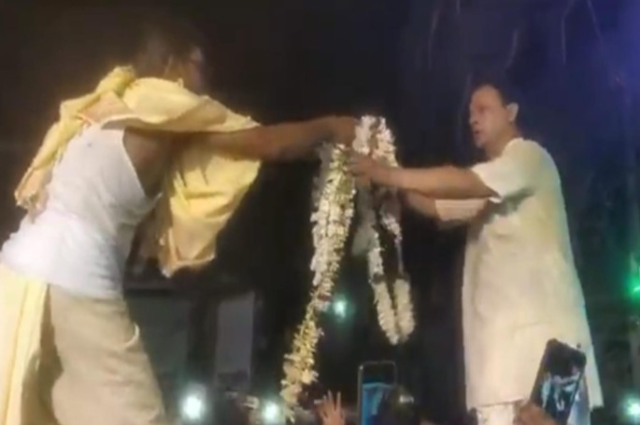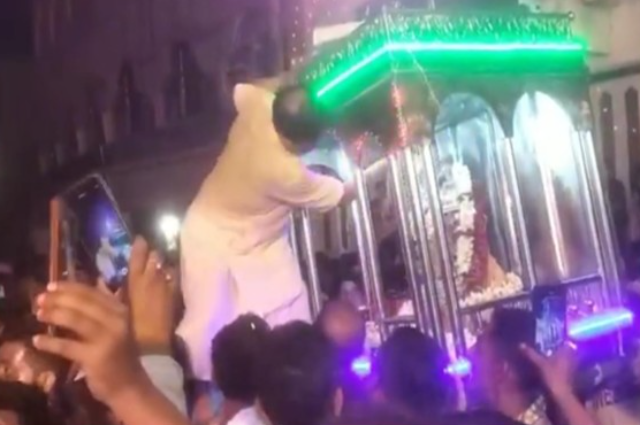
On a moonlit evening in Nabadwip, West Bengal, the town transforms into something between a sacred stage and a street circus. Drums throb, laughter erupts, and a barefoot Shiva — ash-smeared and dreadlocked — dances through the alleys, followed by a motley crew of followers. This isn’t just a religious procession; it’s a living folk epic, a divine marriage reenacted with satire, joy, and fierce local flavor. “Shiber Biya,” as the locals call it, turns myth into masquerade, and devotion into theatre — a celebration that brings gods, people, and parody together under one spirited sky.
Here, gods are not distant; they walk beside us in worn sandals and plastic crowns. The chaos is deliberate, the parody divine. In a world obsessed with control, this ritual is a glorious surrender — to humor, to love, to community, and to the idea that even the holiest stories can be retold with paint, powder, and punchlines. And in this folk theatre of devotion, laughter becomes a prayer, and the wild, ash-covered groom reminds us: the divine isn’t always perfect — sometimes, it’s just beautifully human.
A Myth Reimagined
In Hindu mythology, the union of Shiva and Parvati symbolizes the cosmic balance between asceticism and domesticity, meditation and manifestation. But in Nabadwip, this celestial love story is not recited in temples — it’s performed on the streets, with laughter, ash, and improvised drama. Here, the town celebrates “Shiber Biya” (Shiva’s wedding) on the eve of Maha Shivaratri, turning ancient scripture into a carnival of colors and chaos. The mythology is well known Parvati, after her rebirth from Sati, performs intense penance to win Shiva’s heart. Eventually, the stoic god of destruction accepts her, and their wedding becomes a divine celebration in the Himalayas. But in this Bengal town, the tale is reimagined with a folkloric flair that defies solemnity. Shiva is portrayed as a messy, disoriented groom, often stumbling and cracking jokes, while Parvati remains a symbol of calm and grace. This folk dramatization of their marriage doesn’t aim to replicate myth with precision — instead, it aims to live the myth, reminding us that stories evolve with their storytellers. For the people of Nabadwip, this wedding is not just about the gods — it's about their own joys, frustrations, humor, and identity woven into sacred lore.
The Groom Arrives
As dusk falls, the sounds of conch shells, dhaks (drums), and laughter fill the air. Shiva, clad in loincloth, his body smeared in ash and colored powder, arrives on foot or a decorated rickshaw, accompanied by a wild entourage of followers — the "Bar Yatri" (groom's party). But this isn't your typical divine procession. It's more like a travelling circus of satire. His companions mimic intoxicated sadhus, comical ministers, and local archetypes, often improvising jokes about current politics, inflation, or even corrupt officials. The audience — thousands deep — roars with laughter as Shiva stumbles through the crowd, occasionally pausing to dance, bless a child, or deliver a hilarious one-liner. In this spectacle, divinity is both revered and ridiculed. The performance acts as social therapy — a moment when gods descend to the level of mortals, not to judge them, but to join in their madness. Women peek from balconies, children run alongside the procession, and even the elderly can’t help but grin. There’s a sense that this chaos is cleansing — that in parodying the sacred, the community renews its bond with both the divine and each other. It’s spiritual, it’s theatrical — and it’s entirely Nabadwip.

Sacred Satire with a Social Message
While the event may appear comic, “Shiber Biya” carries subtle — and sometimes sharp — commentary on society. Through the caricature of a penniless, ash-smeared groom and his unkempt entourage, the tradition challenges societal ideals of a “perfect marriage.” In an era of extravagant weddings and social pressures, this portrayal offers a necessary counterpoint. Shiva, despite being a god, arrives without wealth or status — a reminder that love, not luxury, sanctifies union. Local performers, often with no formal training, inject spontaneous political satire into the procession. They may mock corrupt politicians, rising prices, or even trending social media obsessions. This makes the event not just a celebration, but a kind of folk journalism — a place where voices of the street are amplified through performance. The fact that Shiva himself becomes the vessel for such critique elevates the protest to poetic proportions. Instead of incense and hymns, the town’s devotion comes laced with humor, sarcasm, and sometimes rebellion. It is in these playful critiques that the true genius of the tradition lies — allowing people to vent, question, and reflect while remaining within the sacred fold. In that sense, Nabadwip’s Shiva is not just a god of destruction, but also of disruption.
Living Tradition in a Digital Age
In an era when cultural rituals are increasingly curated for Instagram and temple performances are choreographed for TV, “Shiber Biya” retains a refreshing rawness. The event has no official script, no hired actors, no choreographers — just local youth clubs, community elders, and passionate volunteers who keep it alive year after year. Preparations begin weeks in advance, with costumes stitched from old clothes and props made from recycled materials. The entire neighborhood becomes a stage, and everyone a participant. What makes this tradition especially precious is its resistance to commercialization. There are no flashy banners or brand sponsors. Instead, the event thrives on community spirit, oral history, and spontaneous performance. That said, digital threats do loom — attention spans are shrinking, and younger audiences are often more drawn to YouTube reels than to real reels of folklore. Yet, efforts are being made to document the tradition. Cultural researchers, journalists, and even filmmakers have begun to archive the celebration. There’s hope that this living art form will continue — not because it becomes viral, but because it remains vital. As long as people have stories to tell and truths to laugh at, Shiva will continue to marry again and again in the streets of Nabadwip.
A Celebration of the People
Ultimately, “Shiber Biya” is not just a festival — it’s a celebration of the people. Unlike temple-centered rituals that require priests and protocol, this event thrives in the hands of ordinary folks: rickshaw pullers, students, homemakers, teachers. It’s theirs to create, reinterpret, and preserve. In the joyous mayhem of the celebration lies a deeper truth — that faith can be both light-hearted and profound. The wedding of Shiva and Parvati here does not demand silence or solemnity; it demands participation. It invites everyone, regardless of caste, class, or background, to laugh, play, and be part of the story. In that sense, it is an egalitarian ritual — one where the gods come not to be worshipped from a distance, but to walk among the people. And every year, as the ash settles and the drums fade, the town is left with something more than just memories. It is left with reaffirmed community, renewed faith, and a feeling that even in a world of chaos, laughter and love still hold power. In Nabadwip, when Shiva marries again, it's not just a god getting wed — it's the whole town coming alive, once more.

Where Divinity Dances in Dust and Laughter
In a world often torn between rigid tradition and restless modernity, Shiber Biya in Nabadwip stands as a tender rebellion — a reminder that the divine need not always arrive with thunder or fear, but can walk barefoot through alleyways, smeared in ash, laughing with its people. Here, Shiva is not confined to temples or texts. He is real, human, flawed, hilarious — and deeply sacred. Parvati, serene and ever-patient, accepts him not in grandeur, but in simplicity. And together, their union — replayed each year — becomes a living metaphor for love that transcends appearances, rituals, and perfection.
This marriage is not just retold; it is re-lived. Every drumbeat is a heartbeat of the town, every joke a ritual offering, every misstep of the groom a symbol of divine imperfection embraced with joy. Nabadwip does not just worship — it welcomes. It reminds us that the sacred can be messy, loud, irreverent, and yet profoundly beautiful.
As the night fades and Shiva’s barefoot dance comes to an end, what remains is not just memory — but faith, laughter, and the enduring truth that divinity lives not above us, but among us. And perhaps, in the rhythm of this wedding, we find our own sacred union — with the gods, with each other, and with joy itself.
